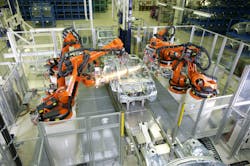The standardization of machine and device communications has been one of the more prominent Holy Grail-type pursuits in the manufacturing industries for many years now. Significant advances have been made on this front recently through the collaborative work of several groups. One of which is FDI, a field device integration group formed by five major automation foundations: FDT Group, Fieldbus Foundation, HART Communications Foundation, OPC Foundation, and Profibus & Profinet International.
As discussions among groups like this progress, manufacturers must forge ahead and create products in a way that enables them to be integrated with other devices and machines as simply as possible. With that in mind, we took an opportunity to learn from KUKA Robotics about how they handle communications to and from their robots.
Dr. Florian Grätz, product owner at KUKA, explained to us that KUKA robots are equipped with multiple busses to connect to the robot’s drives, peripheral devices, a handheld teaching pendant and customer-specific devices. During the production process, Dr. Grätz says an FDT project is “generated for each robot controller containing all KUKA components. Customers can then add their application-specific devices, such as welding guns or gluing guns.”
KUKA began using FDT in its robots in 2007 and delivered its first FDT-based software in 2010. Like most manufacturers, KUKA uses multiple machine and device communication methods. Dr. Grätz explains that KUKA has offered an optional software package for OPC since the 1990s. In addition to OPC there are several access paths to communicate with a KUKA robot, including:
• I/Os transferred via fieldbus protocols;
• USB;
• Serial communications;
• Ethernet (i.e. TCP/IP and UDP/IP sockets); and
• Proprietary data formats.
KUKA started working with FDT following its replacement of different fieldbus controller cards with software packages. As a result, “we created a demand for KUKA's fieldbus configuration software,” says Dr. Grätz. “Previously, we used the configuration software provided by the manufacturer of the fieldbus controller cards.” Dr. Grätz says that KUKA's use of FDT to create its own configuration software not only improved robot communication issues, it also improved company profit.
Creating Robots with FDT
Given that industrial robots are integrated into a larger industrial environment, multiple fieldbuses are typically used in any robotic application. That’s why a common configuration and management tool is required.
The FDT application used by KUKA saves all fieldbus-specific information generated during commissioning in a shared project. Dr. Grätz says, “All FDT device type managers (DTMs) work with one another, even though many different manufacturers supply them. This means that the complex bus scenarios across multiple gateways can be configured without any difficulty thanks to the nested communications capability built into the FDT standard.”
During the multiple-phase robot commissioning process, the initial commissioning phase takes place in the KUKA factory during cabinet assembly. Based on the customer order, an FDT project is created with factory settings. “This includes the bus configuration for the drive technology with converters, various encoder units, special modules and optional special accessories, such as I/O modules,” says Dr. Grätz. “With this configuration in place, the cabinet is ready to operate.”
All robot control systems from KUKA shipped with firmware Version 8.0 and newer are commissioned using FDT technology. As a result, the supported communications include conventional fieldbuses such as DeviceNet, Profibus and Interbus as well as the new Ethernet-based systems such EtherCAT, Profinet and EtherNet/IP. Dr. Grätz notes that “complex scenarios via cascaded gateways and proxies are also implemented using standard FDT technology.”
During the installation and operation phases of deployment, Dr. Grätz says that FDT helps address key issues associated with the addition of third-party field devices and diagnostics.
To put third-party devices into operation with the robot, system integrators can use generic, fieldbus-specific DTMs provided by KUKA. “This derives the corresponding representation in the FDT project from a device description file,” says Dr. Grätz.
“If errors occur during the operation of a robot, for example due to defective wires or peripheral components, users have to determine the cause of the errors quickly and reliably,” Dr. Grätz says. “The capabilities of the DTMs provided with KUKA robots range from monitoring I/Os and analyzing fault memories on the robot’s devices all the way to very detailed analyses, such as determining envelope delay times or damping reserves in fiber-optic cables.”
Watch a KUKA robot being controlled via an iPhone below.
Leaders relevant to this article:


